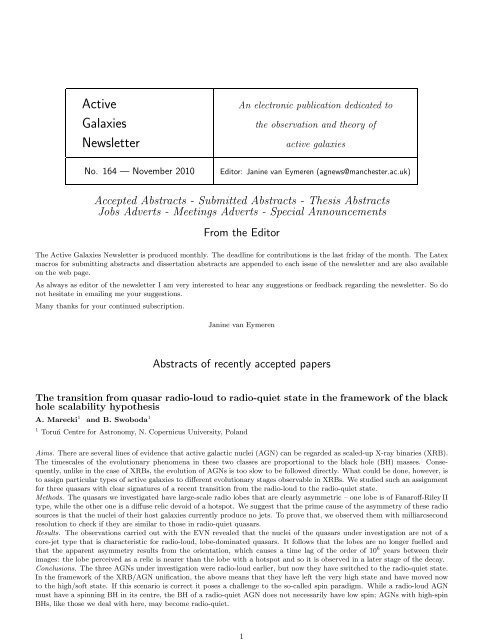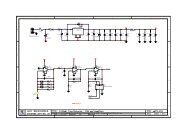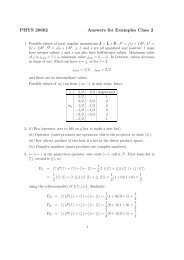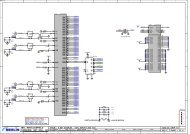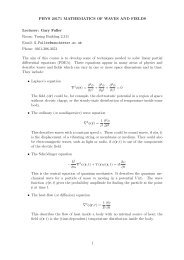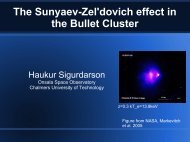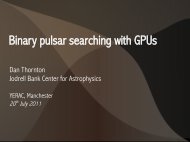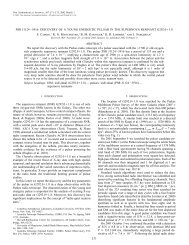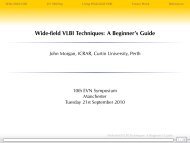Active Galaxies Newsletter
Active Galaxies Newsletter
Active Galaxies Newsletter
Create successful ePaper yourself
Turn your PDF publications into a flip-book with our unique Google optimized e-Paper software.
1<br />
<strong>Active</strong><br />
<strong>Galaxies</strong><br />
<strong>Newsletter</strong><br />
No. 164 — November 2010<br />
An electronic publication dedicated to<br />
the observation and theory of<br />
active galaxies<br />
Editor: Janine van Eymeren (agnews@manchester.ac.uk)<br />
Accepted Abstracts - Submitted Abstracts - Thesis Abstracts<br />
Jobs Adverts - Meetings Adverts - Special Announcements<br />
From the Editor<br />
The <strong>Active</strong> <strong>Galaxies</strong> <strong>Newsletter</strong> is produced monthly. The deadline for contributions is the last friday of the month. The Latex<br />
macros for submitting abstracts and dissertation abstracts are appended to each issue of the newsletter and are also available<br />
on the web page.<br />
As always as editor of the newsletter I am very interested to hear any suggestions or feedback regarding the newsletter. So do<br />
not hesitate in emailing me your suggestions.<br />
Many thanks for your continued subscription.<br />
Janine van Eymeren<br />
Abstracts of recently accepted papers<br />
The transition from quasar radio-loud to radio-quiet state in the framework of the black<br />
hole scalability hypothesis<br />
A. Marecki 1 and B. Swoboda 1<br />
1 Toruń Centre for Astronomy, N. Copernicus University, Poland<br />
Aims. There are several lines of evidence that active galactic nuclei (AGN) can be regarded as scaled-up X-ray binaries (XRB).<br />
The timescales of the evolutionary phenomena in these two classes are proportional to the black hole (BH) masses. Consequently,<br />
unlike in the case of XRBs, the evolution of AGNs is too slow to be followed directly. What could be done, however, is<br />
to assign particular types of active galaxies to different evolutionary stages observable in XRBs. We studied such an assignment<br />
for three quasars with clear signatures of a recent transition from the radio-loud to the radio-quiet state.<br />
Methods. The quasars we investigated have large-scale radio lobes that are clearly asymmetric – one lobe is of Fanaroff-Riley II<br />
type, while the other one is a diffuse relic devoid of a hotspot. We suggest that the prime cause of the asymmetry of these radio<br />
sources is that the nuclei of their host galaxies currently produce no jets. To prove that, we observed them with milliarcsecond<br />
resolution to check if they are similar to those in radio-quiet quasars.<br />
Results. The observations carried out with the EVN revealed that the nuclei of the quasars under investigation are not of a<br />
core-jet type that is characteristic for radio-loud, lobe-dominated quasars. It follows that the lobes are no longer fuelled and<br />
that the apparent asymmetry results from the orientation, which causes a time lag of the order of 10 6 years between their<br />
images: the lobe perceived as a relic is nearer than the lobe with a hotspot and so it is observed in a later stage of the decay.<br />
Conclusions. The three AGNs under investigation were radio-loud earlier, but now they have switched to the radio-quiet state.<br />
In the framework of the XRB/AGN unification, the above means that they have left the very high state and have moved now<br />
to the high/soft state. If this scenario is correct it poses a challenge to the so-called spin paradigm. While a radio-loud AGN<br />
must have a spinning BH in its centre, the BH of a radio-quiet AGN does not necessarily have low spin; AGNs with high-spin<br />
BHs, like those we deal with here, may become radio-quiet.
2<br />
Accepted by A&A<br />
E-mail contact: amr@astro.uni.torun.pl,<br />
preprint available at arXiv:1010.0651<br />
A Multi-Wavelength Study of the Nature of Type 1.8/1.9 Seyfert <strong>Galaxies</strong><br />
M. L. Trippe 1 , D. M. Crenshaw 2 , R. P. Deo 3 , M. Dietrich 4 , S. B. Kraemer 5 , S. E. Rafter 6 , and T. J. Turner 7<br />
1 Department of Astronomy, University of Maryland, College Park, MD 20742<br />
2 Department of Physics and Astronomy, Georgia State University, One Park Place South SE, Ste. 700, Atlanta, GA 30303<br />
3 Drexel University Department of Physics, Disque Hall, South 32nd St., Rm. 813, Philadelphia, PA 19104<br />
4 Department of Astronomy, The Ohio State University, 4055 McPherson Lab 140 W. 18th Ave. Columbus, OH, 43210<br />
5 Institute for Astrophysics and Computational Sciences, Department of Physics, The Catholic University of America, Washington,<br />
DC 20064<br />
6 Dept. of Physics, Technion, Haifa 32000, Israel<br />
7 Dept. of Physics, University of Maryland Baltimore County, 1000 Hilltop Circle, Baltimore, MD 21250<br />
We focus on determining the underlying physical cause of a Seyfert galaxy’s appearance as type a 1.8 or 1.9. Are these<br />
“intermediate” Seyfert types typical Seyfert 1 nuclei with reddened broad-line regions? Or are they objects with intrinsically<br />
weak continua and broad emission lines? We compare measurements of the optical reddening of the narrow and broad-line<br />
regions with each other and with the X-ray column derived from XMM-Newton 0.5-10 keV spectra to determine the presence<br />
and location of dust in the line of sight. We also searched the literature to see if the objects showed evidence for broad-line<br />
variability, and determined if the changes were consistent with a change in reddening or a change in the intrinsic ionizing<br />
continuum flux. We find that 10 of 19 objects previously classified as Seyfert 1.8/1.9s received this designation due to their<br />
low continuum flux. In four objects the classification was due to BLR reddening, either by the torus or dust structures in the<br />
vicinity of the NLR; in the remaining five objects there is not sufficient evidence to favor one scenario over the other. These<br />
findings imply that, in general, samples of 1.8/1.9s are not suitable for use in studies of the gas and dust in the central torus.<br />
Accepted by ApJ.<br />
E-mail contact: trippe[at]astro.umd.edu,<br />
preprint available at arXiv:1010.2750<br />
Stability of cloud orbits in the broad-line region of active galactic nuclei<br />
Martin Krause 1,2 , Andreas Burkert 1,2,3 , Marc Schartmann 1,2<br />
1 Max-Planck-Institut für Extraterrestrische Physik, Giessenbachstrasse, 85748 Garching, Germany<br />
2 Universitätssternwarte München, Scheinerstr. 1, 81679 München, Germany<br />
3 Max-Planck-Fellow<br />
We investigate the global dynamic stability of spherical clouds in the Broad Line Region (BLR) of <strong>Active</strong> Galactic Nuclei<br />
(AGN), exposed to radial radiation pressure, gravity of the central black hole (BH), and centrifugal forces assuming the clouds<br />
adapt their size according to the local pressure. We consider both, isotropic and anisotropic light sources. In both cases,<br />
stable orbits exist also for very sub-Keplerian rotation for which the radiation pressure contributes substantially to the force<br />
budget. We demonstrate that highly eccentric, very sub-Keplerian stable orbits may be found. This gives further support for<br />
the model of Marconi et al., who pointed out that black hole masses might be significantly underestimated if radiation pressure<br />
is neglected. That model improved the agreement between black hole masses derived in certain active galaxies based on BLR<br />
dynamics, and black hole masses derived by other means in other galaxies by inclusion of a luminosity dependent term. For<br />
anisotropic illumination, energy is conserved for averages over long time intervals, only, but not for individual orbits. This leads<br />
to Rosetta orbits that are systematically less extended in the direction of maximum radiation force. Initially isotropic relatively<br />
low column density systems would therefore turn into a disk when an anisotropic AGN is switched on.<br />
Accepted by MNRAS<br />
E-mail contact: krause@mpe.mpg.de,<br />
preprint available at astro-ph/1007.0112
3<br />
Implications of Dramatic Broad Absorption Line Variability in the Quasar FBQS J1408+3054<br />
P. B. Hall 1 , K. Anosov 1 , R. L. White 2 , W. N. Brandt 3 , M. D. Gregg 4,5 , R. R. Gibson 6 , R. H. Becker 4,5 , and<br />
D. P. Schneider 3<br />
1 Department of Physics and Astronomy, York University, Toronto, ON, Canada<br />
2 Space Telescope Science Institute, Baltimore, MD, USA<br />
3 Department of Astronomy & Astrophysics, Pennsylvania State University, University Park, PA, USA<br />
4 Department of Physics, University of California Davis, Davis, CA, USA<br />
5 IGPP, Lawrence Livermore National Laboratory, Livermore, CA, USA<br />
6 Department of Astronomy, University of Washington, Seattle, WA, USA<br />
We have observed a dramatic change in the spectrum of the formerly heavily absorbed ‘overlapping-trough’ iron low-ionization<br />
broad absorption line (FeLoBAL) quasar FBQS J1408+3054. Over a time span of between 0.6 to 5 rest-frame years, the Mgii<br />
trough outflowing at 12,000 km s −1 decreased in equivalent width by a factor of two and the [Feii] troughs at the same velocity<br />
disappeared. The most likely explanation for the variability is that a structure in the BAL outflow moved out of our line of<br />
sight to the ultraviolet continuum emitting region of the quasar’s accretion disk. Given the size of that region, this structure<br />
must have a transverse velocity of between 1300 km s −1 and 11,000 km s −1 . In the context of a simple outflow model, we<br />
show that this BAL structure is located between approximately 7300 and 73,000 Schwarzschild radii from the black hole. That<br />
distance corresponds to 2.2 to 22 pc, 14 to 140 times farther from the black hole than the Hβ broad-line region. The high<br />
velocities and the parsec-scale distance for at least this one FeLoBAL outflow mean that not all FeLoBAL outflows can be<br />
associated with galaxy-scale outflows in ultraluminous infrared galaxies transitioning to unobscured quasars. The change of<br />
FBQS J1408+3054 from an FeLoBAL to a LoBAL quasar also means that if (some) FeLoBAL quasars have multiwavelength<br />
properties which distinguish them from HiBAL quasars, then some LoBAL quasars will share those properties. Finally, we<br />
extend previous work on how multiple-epoch spectroscopy of BAL and non-BAL quasars can be used to constrain the average<br />
lifetime of BAL episodes (currently >60 rest-frame years at 90% confidence).<br />
Accepted by MNRAS<br />
E-mail contact: phall@yorku.ca,<br />
preprint available at http://arxiv.org/abs/1010.3728<br />
X-QUEST: A Comprehensive X-ray Study of Local ULIRGs and QSOs<br />
Stacy H. Teng 1 and Sylvain Veilleux 1<br />
1 Department of Astronomy, University of Maryland, College Park, MD, 20742, USA<br />
We present results from the X-ray portion of a multi-wavelength study of local ULIRGs and QSOs called QUEST (Quasar-<br />
ULIRG Evolution STudy). The data consist of new and archival X-ray data on 40 ULIRGs and 26 PG QSOs taken with<br />
Chandra and XMM-Newton. A combination of traditional and hardness ratio spectral fitting methods is used to characterize<br />
the X-ray properties of these objects. The absorption-corrected 2-10 keV to bolometric luminosity ratios of the ULIRGs and<br />
PG QSOs suggest that the likelihood for dominant nuclear activity increases along the merger sequence from “cool” ULIRGs,<br />
“warm” ULIRGs, infrared-bright QSOs, and infrared-faint QSOs. The starburst dominates the total power in ULIRGs prior to<br />
the merger, and this is followed by rapid black hole growth during and after coalescence. These results are in general agreement<br />
with those obtained in the mid-infrared with Spitzer and recent numerical simulations.<br />
Accepted by The Astrophysical Journal<br />
E-mail contact: stacyt@astro.umd.edu,<br />
preprint available at http://arxiv.org/abs/1010.4027<br />
Hot-Dust-Poor Type 1 AGNs in the COSMOS Survey<br />
Heng Hao 1 , Martin Elvis 1 , Francesca Civano 1 , Giorgio Lanzuisi 1,2 , Marcella Brusa 3 , Elisabeta Lusso 4 , Gianni<br />
Zamorani 4 , Andrea Comastri 4 , Angela Bongiorno 3 , Chris D. Impey 5 , Anton M. Koekemoer 6 , Emeric Le Floc’h 7 ,<br />
Mara Salvato 8 , David Sanders 7 , Jonathan R. Trump 5 , and Cristian Vignali 9<br />
1 Harvard-Smithsonian Center for Astrophysics, 60 Garden Street, Cambridge, MA 02138<br />
2 INAF - IASF Roma, Via del Fosso del Cavaliere 100, 00133 Roma, Italy<br />
3 Max Planck Institut für extraterrestrische Physik Giessenbachstrasse 1, D–85748 Garching, Germany<br />
4 INAF-Osservatorio Astronomico di Bologna, via Ranzani 1, I-40127 Bologna, Italy<br />
5 Steward Observatory, University of Arizona, 933 North Cherry Avenue, Tucson, AZ 85721, USA<br />
6 Space Telescope Science Institute, 3700 San Martin Drive, Baltimore, MD 21218, USA<br />
7 Institute for Astronomy, University of Hawaii,2680 Woodlawn Drive, Honolulu, HI 96822 USA
4<br />
8 IPP - Max-Planck-Institute for Plasma Physics, Boltzmannstrasse 2, D-85748, Garching, Germany<br />
9 Dipartimento di Astronomia, Università degli Studi di Bologna, Via Ranzani 1, I-40127 Bologna, Italy<br />
We report a sizable class of type 1 AGNs with unusually weak near-infrared (1 − 3µm) emission in the XMM-COSMOS type<br />
1 AGN sample. The fraction of these “hot-dust-poor” AGNs increases with redshift from 6% at low redshift (z < 2) to 20%<br />
at moderate high redshift (2 < z < 3.5). There is no clear trend of the fraction with other parameters: bolometric luminosity,<br />
Eddington ratio, black hole mass and X-ray luminosity. The 3µm emission relative to the 1µm emission is a factor of two to<br />
four smaller than the typical Elvis et al. (1994) AGN spectral energy distribution, which indicates a ‘torus’ covering factor of<br />
2%–29%, a factor of three to forty smaller than required by unified models. The weak hot dust emission seems to expose an<br />
extension of the accretion disk continuum in some of the source SEDs. We estimate the outer edge of their accretion disks to<br />
lie at (0.3 − 2.0) × 10 4 Schwarzschild radii, ∼10–23 times the gravitational stability radii. Formation scenarios for these sources<br />
are discussed.<br />
Accepted by ApJ Letter<br />
E-mail contact: hhao@cfa.harvard.edu,<br />
preprint available at http://arxiv.org/abs/1009.3276<br />
The Compton shoulder of the Fe Kα fluorescent emission line in active galactic nuclei<br />
Tahir Yaqoob 1 and Kendrah D. Murphy 2,3<br />
1 Department of Physics and Astronomy, Johns Hopkins University, Baltimore, MD 21218.<br />
2 MIT Kavli Institute for Astrophysics and Space Research, 77 Massachusetts Avenue, NE80-6013, Cambridge, MA 02139.<br />
3 Department of Physics, Skidmore College, 815 North Broadway, Saratoga Springs, NY 12866.<br />
We present new, high signal-to-noise ratio results from a Monte Carlo study of the properties of the Compton shoulder of the<br />
Fe Kα emission line in the toroidal X-ray reprocessor model of Murphy & Yaqoob (2009). The model is valid for equatorial<br />
column densities in the range 10 22 cm −2 to 10 25 cm −2 , which comprehensively covers the Compton-thin to Compton-thick<br />
regimes. We show how the shape of the Compton shoulder and its flux relative to the core of the Fe Kα emission line depend<br />
on the torus column density and orientation, for the case of a half-opening angle of 60 ◦ and cosmic abundances. The variety of<br />
Compton shoulder profiles is greater than that for both (centrally-illuminated) spherical and disk geometries. Our Monte Carlo<br />
simulations were done with a statistical accuracy that is high enough to reveal, for the case of an edge-on, Compton-thick torus,<br />
a new type of Compton shoulder that is not present in the spherical or disk geometries. Such a Compton shoulder is dominated<br />
by a narrow back-scattering feature peaking at ∼ 6.24 keV. Our results are also sensitive enough to reveal a dependence of the<br />
shape of the Compton shoulder (and its magnitude relative to the Fe Kα line core) on the spectral shape of the incident X-ray<br />
continuum. We also present results of the effect of velocity broadening on the Fe Kα line profile and find that if either the<br />
velocity width or instrument resolution is greater than a FWHM of ∼ 2000 km s −1 , the Compton shoulder begins to become<br />
blended with the line core and the characteristic features of the Compton shoulder become harder to resolve. In particular, at<br />
a FWHM of ∼ 7000 km s −1 the Compton shoulder is not resolved at all, its only signature being a weak asymmetry in the<br />
blended line profile. This means that CCD X-ray detectors cannot unambiguously resolve the Compton shoulder. Our results<br />
are freely available in a format that is suitable for direct spectral-fitting of the continuum and line model to real data.<br />
Accepted by MNRAS<br />
E-mail contact: yaqoob at pha. jhu. edu, preprint available at arXiv<br />
Polycyclic Aromatic Hydrocarbon and Emission Line Ratios in <strong>Active</strong> Galactic Nuclei<br />
and Starburst <strong>Galaxies</strong>.<br />
Sales, Dinalva A. 1 , Pastoriza, M. G. 1,2 and Riffel, R. 1<br />
1 Departamento de Astronomia, Universidade Federal do Rio Grande do Sul. Av. Bento Gonçalves 9500, Porto Alegre, RS,<br />
Brazil<br />
2 Conselho Nacional de Desenvolvimento Científico e Tecnológico, Brazil<br />
We study the polycyclic aromatic hydrocarbons (PAH) bands, ionic emission lines, and mid-infrared continuum properties, in<br />
a sample of 171 emission line galaxies taken from the literature plus 15 new active galactic nucleus (AGN) Spitzer spectra.<br />
We normalize the spectra at λ=23µm and grouped them according to the type of nuclear activity. The continuum shape<br />
steeply rises for longer wavelengths and can be fitted with a warm blackbody distribution of T ∼ 150 –300K. The brightest<br />
PAH spectral bands (6.2, 7.7, 8.6, 11.3, and 12.7 µm) and the forbidden emission lines of [Siii] 34.8 µm, [Arii] 6.9 µm, [S iii]<br />
18.7 and 33.4 µm were detected in all the starbursts and in ∼80% of the Seyfert 2. Taking under consideration only the PAH<br />
bands at 7.7µm, 11.3µm, and 12.7µm we find that they are present in ∼80% of the Seyfert 1, while only half of this type of
5<br />
activity show the 6.2µm and 8.6 µm PAH bands. The observed intensity ratios for neutral and ionized PAHs (6.2µm/7.7µm<br />
× 11.3µm/7.7µm) were compared to theoretical intensity ratios, showing that AGNs have higher ionization fraction and larger<br />
PAH molecules (≥ 180 carbon atoms) than SB galaxies. The ratio between the ionized (7.7µm) and the neutral PAH bands<br />
(8.6µm and 11.3µm) are distributed over different ranges for AGNs and SB galaxies, suggesting that these ratios could depend<br />
on the ionization fraction, as well as on the hardness of the radiation field. The ratio between the 7.7µm and 11.3µm bands<br />
is nearly constant with the increase of [Neiii]15.5µm/[Neii] 12.8µm, indicating that the fraction of ionized to neutral PAH<br />
bands does not depend on the hardness of the radiation field. The equivalent width of both PAH features show the same<br />
dependence (strongly decreasing) with [Neiii]/[Neii], suggesting that the PAH molecules, emitting either ionized (7.7µm) or<br />
neutral (11.3µm) bands, may be destroyed with the increase of the hardness of the radiation field.<br />
Accepted by ApJ 2010<br />
E-mail contact: dinalva.aires@ufrgs.br,<br />
DRAFT is available at Preprints.html<br />
X-ray Emission from Optically Selected Radio-Intermediate and Radio-Loud Quasars<br />
B. P. Miller 1,2,3 , W. N. Brandt 1,4 , D. P. Schneider 1 , R. R. Gibson 5 , A. T. Steffen 6 , and Jianfeng Wu 1,4<br />
1 Department of Astronomy and Astrophysics, The Pennsylvania State University, 525 Davey Laboratory, University Park, PA<br />
16802<br />
2 Department of Physics, The College of Wooster, 308 East University Street, Wooster, OH 44691<br />
3 Department of Astronomy, University of Michigan, 500 Church Street, Ann Arbor, MI 48109<br />
4 Institute for Gravitation and the Cosmos, The Pennsylvania State University, University Park, PA 16802<br />
5 Department of Astronomy, University of Washington, Box 351580, Seattle, WA 98195<br />
6 Department of Astronomy, University of Wisconsin Marathon County, 518 S. 7th Avenue, Wausau, WI 54401<br />
We present the results of an investigation into the X-ray properties of radio-intermediate and radio-loud quasars (RIQs and<br />
RLQs, respectively). We combine large, modern optical (e.g., SDSS) and radio (e.g., FIRST) surveys with archival X-ray data<br />
from Chandra, XMM-Newton, and ROSAT to generate an optically selected sample that includes 188 RIQs and 603 RLQs.<br />
This sample is constructed independently of X-ray properties but has a high X-ray detection rate (85%); it provides broad<br />
and dense coverage of the l − z plane, including at high redshifts (22% of objects have z = 2 − 5), and it extends to high<br />
radio-loudness values (33% of objects have R ∗ = 3 − 5, using logarithmic units). We measure the “excess” X-ray luminosity of<br />
RIQs and RLQs relative to radio-quiet quasars (RQQs) as a function of radio loudness and luminosity, and parameterize the<br />
X-ray luminosity of RIQs and RLQs both as a function of optical/UV luminosity and also as a joint function of optical/UV and<br />
radio luminosity. RIQs are only modestly X-ray bright relative to RQQs; it is only at high values of radio-loudness (R ∗ > ∼ 3.5)<br />
and radio luminosity that RLQs become strongly X-ray bright. We find no evidence for evolution in the X-ray properties of<br />
RIQs and RLQs with redshift (implying jet-linked IC/CMB emission does not contribute substantially to the nuclear X-ray<br />
continuum). Finally, we consider a model in which the nuclear X-ray emission contains both disk/corona-linked and jet-linked<br />
components and demonstrate that the X-ray jet-linked emission is likely beamed but to a lesser degree than applies to the radio<br />
jet. This model is used to investigate the increasing dominance of jet-linked X-ray emission at low inclinations.<br />
Accepted by ApJ<br />
E-mail contact: mbrendan@umich.edu,<br />
preprint available at arXiv:1010.4804<br />
Spectral variability of quasars from multi-epoch photometric data in the Sloan Digital<br />
Sky Survey Stripe 82<br />
H. Meusinger 1 , A. Hinze 2 , A. de Hoon 3<br />
1 Thüringer Landessternwarte Tautenburg, Sternwarte 5, D–07778 Tautenburg, Germany<br />
2 Astronomisches Institut, Universität Bern, Sidlerstraße 5, CH–3012 Bern, Switzerland<br />
3 Astrophysikalisches Institut Potsdam, An der Sternwarte 16, D–14482 Potsdam, Germany<br />
The study of the ensemble properties of the UV/optical broadband variability of quasars is hampered by the combined effects of<br />
the dependence of variability on timescale, rest frame wavelength, and luminosity. Here, we present a new approach to analysing<br />
the dependence of quasar variability on rest frame wavelengths. We exploited the spectral archive of the Sloan Digital Sky Survey<br />
(SDSS) to create a sample of over 9000 quasars in the Stripe 82. The quasar catalogue was matched with the Light Motion Curve<br />
Catalogue for SDSS Stripe 82 and first-order structure functions were computed from the lightcurves. The structure functions<br />
are used to create a variability indicator that is related to the same intrinsic timescales for all quasars (about 1 to 2 yr in the rest<br />
frame). We study the variability ratios for adjacent SDSS filter bands as a function of redshift. A quantitative interpretation
6<br />
of these relations is provided by comparing with the results of simple Monte Carlo simulations of variable quasar spectra. We<br />
confirm the well-known dependence of variability on time-lag; the best power-law fit of the sample-averaged structure function<br />
has a slope β = 0.31 ± 0.03. We also confirm that anti-correlations exist with luminosity, wavelength, and redshift where the<br />
latter can be fully explained as a consequence of the former two dependencies. The variability ratios as a function of redshift<br />
resemble the corresponding colour index-redshift relations. While variability is almost always stronger in the bluer passband<br />
than in the redder, the variability ratio depends on whether strong emission lines contribute to either one band or the other.<br />
We find that the observed variability ratio-redshift relations are well described assuming that (a) the r.m.s. fluctuation of the<br />
quasar continuum flux follows a power law σ(f λ ) ∝ λ −2 (i.e., is bluer when brighter) and (b) the variability of the emission line<br />
flux is only ∼ 10% of that of the underlying continuum. These results, based upon the photometry of more than 8000 quasars,<br />
confirm the previous findings of Wilhite et al. (2005) for 315 quasars with repeated SDSS spectroscopy. Finally, we find that<br />
quasars with unusual spectra and weak emission lines tend to have less variability than conventional quasars. This trend is the<br />
opposite of that expected from the dilution effect of variability due to line emission and may be indicative of high Eddington<br />
ratios in these unusual quasars.<br />
Accepted by A&A<br />
E-mail contact: meus@tls-tautenburg.de,<br />
preprint available at http://fr.arxiv.org/abs/1010.5386<br />
The energy budget for X-ray to infrared reprocessing in Compton-thin and Comptonthick<br />
active galaxies<br />
Tahir Yaqoob 1 and Kendrah D. Murphy 2<br />
1 Department of Physics and Astronomy, Johns Hopkins University, Baltimore, MD 21218.<br />
2 Department of Physics, Skidmore College, 815 North Broadway, Saratoga Springs, NY 12866.<br />
Heavily obscured active galactic nuclei (AGNs) play an important role in contributing to the cosmic X-ray background (CXRB).<br />
However, the AGNs found in deep X-ray surveys are often too weak to allow direct measurement of the column density<br />
of obscuring matter. One method adopted in recent years to identify heavily obscured, Compton-thick AGNs under such<br />
circumstances is to use the observed mid-infrared to X-ray luminosity ratio as a proxy for the column density. This is based on<br />
the supposition that the amount of energy lost by the illuminating X-ray continuum to the obscuring matter and reprocessed into<br />
infrared emission is directly related to the column density and that the proxy is not sensitive to other physical parameters of the<br />
system (aside from contamination by dust emission from, for example, star-forming regions). Using Monte Carlo simulations,<br />
we find that the energy losses experienced by the illuminating X-ray continuum in the obscuring matter are far more sensitive<br />
to the shape of the X-ray continuum and to the covering factor of the X-ray reprocessor than they are to the column density of<br />
the material. Specifically we find that it is possible for the infrared to X-ray luminosity ratio for a Compton-thin source to be<br />
just as large as that for a Compton-thick source even without any contamination from dust. Since the intrinsic X-ray continuum<br />
and covering factor of the reprocessor are poorly constrained from deep X-ray survey data, we conclude that the mid-infrared to<br />
X-ray luminosity ratio is not a reliable proxy for the column density of obscuring matter in AGNs even when there is no other<br />
contribution to the mid-infrared luminosity aside from X-ray reprocessing. This conclusion is independent of the geometry of<br />
the obscuring matter.<br />
Accepted by MNRAS<br />
E-mail contact: yaqoob@pha.jhu.edu
7<br />
Orientation Effects on the Inner Region of Dusty Torus of <strong>Active</strong> Galactic Nuclei<br />
Toshihiro Kawaguchi and Masao Mori<br />
Center for Computational Sciences, University of Tsukuba, Tsukuba, Ibaraki 305-8577, Japan<br />
A sublimation process governs the innermost region of the dusty torus of active galactic nuclei. However, the observed inner<br />
radius of the torus is systematically smaller than the expected radius by a factor of ∼ 1/3. We show that the anisotropy of the<br />
emission from accretion disks resolves this conflict naturally and quantitatively. An accretion disk emits lesser radiation in the<br />
direction closer to its equatorial plane (i.e., to the torus). We find that the anisotropy makes the torus inner region closer to<br />
the central black hole and concave. Moreover, the innermost edge of the torus may connect with the outermost edge of the disk<br />
continuously. Considering the anisotropic emission of each clump in the torus, we calculate the near-infrared flux variation in<br />
response to a UV flash. For an observer at the polar angle θ obs = 25 ◦ , the centroid of the time delay is found to be 37% of the<br />
delay expected in the case of isotropic illumination, which explains the observed systematic deviation.<br />
Accepted by The Astrophysical Journal Letter<br />
E-mail contact: kawaguti@ccs.tsukuba.ac.jp,<br />
preprint available at http://arxiv.org/abs/1010.5799
8<br />
Meetings<br />
The Starburst-AGN Connection under the Multiwavelength Limelight<br />
ESAC, Villanueva de la Cañada (Madrid), Spain<br />
September 14-16, 2011<br />
Webpage: http://www.sciops.esa.int/index.php?project=ESACFACULTY&page=workshop starburstAGN2011<br />
Email: sbagn esac2011@sciops.esa.int<br />
The European Space Agency (ESA) Faculty is pleased to announce the international workshop: ”Starburst-AGN connection<br />
under the multiwavelength limelight”. The workshop will be held at the European Space Astronomy Center of ESA (ESAC),<br />
Villanueva de la Cañada (Madrid), Spain, on September 14-16, 2011.<br />
This workshop aims at gathering observational and theoretical astronomers so as to answer the following questions:<br />
- The ”Starburst-AGN Connection”: a causal relation? With which trend?<br />
- ”Starburst-AGN Connection” at low and high redshift: any evidence for evolution?<br />
- Is there a connection between AGN obscuration and star formation?<br />
- In which way are the star formation and AGN phenomena affected by the environment (i.e. interactions, host galaxy type,<br />
bars)?<br />
- Do stars contribute to AGN fuelling?<br />
Perspective participants are encouraged to visit the workshop web page:<br />
http://www.sciops.esa.int/index.php?project=ESACFACULTY&page=workshop starburstAGN2011,<br />
or contact the workshop organisers at: sbagn esac2011@sciops.esa.int<br />
Important Deadlines:<br />
- First announcement (i.e. this one): October 15, 2010<br />
- Second announcement with registration deadline: February 2011<br />
- Registration deadline: April 2011<br />
- Final program: June 2011<br />
- Workshop: 14-16 September 2011<br />
Narrow-Line Seyfert 1 <strong>Galaxies</strong> and their place in the Universe<br />
Milano, Italy<br />
April 4-6, 2011<br />
Webpage: http://nls1.brera.inaf.it/<br />
Email: nls1@brera.inaf.it<br />
In 1978, Davidson and Kinman wrote about Markarian 359: “This unusual object merits further observations...”. In 1985,<br />
Osterbrock and Pogge defined a new class of active galactic nuclei (AGN), named Narrow-Line Seyfert 1 (NLS1). Twenty-five<br />
years later, NLS1s still continue to intrigue and bewilder. NLS1s manifest extreme behaviour at all wavelengths. They exhibit<br />
the most extreme X-ray variability seen in radio-quiet AGN, the most intense optical FeII emission, and high rates of star<br />
formation. In general, their characteristics are consistent of AGNs with relatively low mass black holes accreting close to the<br />
Eddington rate. The 2009 Fermi Gamma-ray Space Telescope discovery of high-energy (E > 100 MeV) gamma rays in a handful<br />
of NLS1s has established the existence of relativistic jets in these systems – a fact previously hinted at by the flat radio spectrum<br />
and high brightness temperature seen in some objects. Since NLS1 are generally hosted by spirals, this poses some intriguing<br />
questions on the galaxy evolution and on how relativistic jets are generated.<br />
It is therefore time for the broad community to come together and discuss what we have discovered in the last quarter century<br />
and lay the foundation for future work. We propose to meet in Milano on April 4-6 2011 for a workshop dedicated to NLS1<br />
and focused on these topics:<br />
- Central engine: BH mass, accretion disk, BLR/NLR, jet
9<br />
- Host galaxy: morphology, star formation, merging history<br />
- NLS1 in the Universe: comparison with other types of AGN, surveys/statistics, formation/merging, cosmological evolution<br />
Invited speakers:<br />
- Todd Boroson<br />
- Andy Fabian (to be confirmed)<br />
- Bradley Peterson<br />
- Richard Pogge<br />
Deadline for abstract submission and registration: 31 January 2011<br />
Scientific Organizing Committee: M. Colpi (University Milano Bicocca, Italy); L. Foschini (INAF OA Brera, Italy,<br />
Chair); L. Gallo (St. Mary’s University, Canada); D. Grupe (Penn State University, USA); S. Komossa (MPE, Germany);<br />
K. Leighly (University of Oklahoma, USA); S. Mathur (Ohio State University, USA).<br />
Local Organizing Committee: C. Bernasconi; G. Bonnoli; G. Ghirlanda; G. Ghisellini; F. Taddei; F. Tavecchio.


